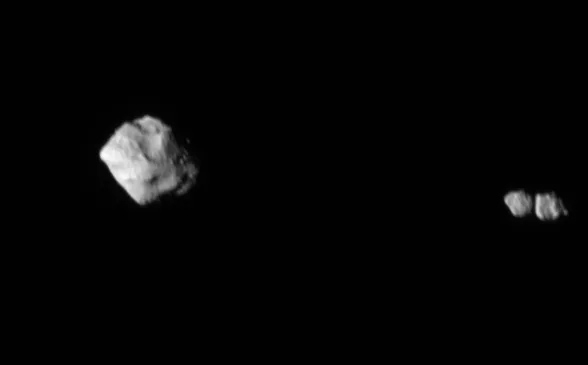Yo, I heard you liked asteroids, so I got you another asteroid.
Updates:
(November 28, 2023): Dinkinesh's moon now has a name: Selam.
(November 8, 2023): The Lucy mission surprises again! While the probe caught a view of the Dinkinesh's small satellite in the one of the first images of the flyby, the mission turned as it flew by and captured another view from a different angle. That new perspective revealed that the little asteroidal moon is actually a contact binary, meaning it's made of two objects in contact with one another. This is the first contact binary asteroid moon discovered. Read more details on NASA's website.

NASA / Goddard / SwRI / Johns Hopkins APL

NASA / Goddard / SwRI / Johns Hopkins APL / NOIRLab
On November 1st, the Lucy mission zipped past the tiny asteroid 152830 Dinkinesh and discovered that it was actually a binary. The flyby was an opportunity to test out the spacecraft’s autonomous tracking capability, a technology that will be crucial for Lucy’s future plans to explore seven Trojan asteroid systems, all of which share Jupiter’s orbit. The fact that the test target turned out to be two targets was an unexpected challenge for navigation, but one that Lucy passed with flying colors.
Before the flyby, scientists used archival data from the Wide-field Infrared Survey Explorer (WISE) mission to estimate Dinkinesh’s diameter at between 550 and 870 meters (1,800 to 2,900 feet) in diameter, with its most likely size being 760 meters. That estimate was spot-on; Lucy scientists report an initial estimate of 790 meters for the primary’s diameter at the equator. (Its pole-to-pole diameter will be somewhat shorter.) The companion is an estimated 220 meters across. The excellent estimate bolsters confidence in other asteroid diameters measured by WISE.
Although not the smallest asteroid ever visited by a spacecraft, Dinkinesh and its companion are the smallest main-belt asteroids ever seen up close. They clearly resemble the recently visited near-Earth asteroids 101955 Bennu and 162173 Ryugu, with boulders perched on their surfaces, soft dents of craters, and bulging midlines. So the Dinkinesh pair, too, are likely rubble piles, agglomerations of rocks and dust loosely held together by gravity.
Binaries are very common in the asteroid belt as well as the Kuiper belt. It’s likely they didn’t start out as binaries, though. A set of phenomena referred to as the YORP effect can cause asteroids to spin faster and faster until they begin to shed mass at the waist. The breakaway material would initially form a ring but eventually coalesces into a companion body. The shed material takes the majority of the formerly fast-spinning body’s angular momentum with it, slowing its spin way down. The final state of the binary is mutual spin-orbit locking, so that they keep the same faces pointed at each other forever.
Lucy has now left Dinkinesh behind, but it’s still returning data to Earth. Its next planned encounter will be with another main-belt asteroid, 52246 Donaldjohanson, on April 20, 2025.
 6
6









Comments
StanR
November 4, 2023 at 2:46 am
How far apart are the two "rocks"?
You must be logged in to post a comment.
kdconod
November 7, 2023 at 6:41 pm
And now we find Dinky's moon is a binary!
You must be logged in to post a comment.
Monica Young
November 8, 2023 at 11:42 am
Indeed! We've updated the story 🙂
You must be logged in to post a comment.
Anthony Barreiro
November 10, 2023 at 7:19 pm
The lede in the original article says, "Yesterday, the Lucy mission zipped past the tiny asteroid 152830 Dinkinesh ..." but the article is now dated November 8.
You must be logged in to post a comment.
Monica Young
November 14, 2023 at 11:19 am
Keeping us honest ;). Thanks for the sharp eye!
You must be logged in to post a comment.
gmk
November 10, 2023 at 2:09 pm
Although the 1700UTC Nov 1 image suggests a contact binary, it does not in-and-of-itself constitute proof. The asteroids appear to be illuminated from left to right, as indicated by the sharp, near-vertical terminator on the left side of the right member of the satellite. Without an image of what lies in the shadow between the two satellite components, it is not possible to determine whether they are two distinct objects or whether they are two lobes of the same object that are connected by a narrow neck (as per comet 67P/Churyumov–Gerasimenko).
You must be logged in to post a comment.
You must be logged in to post a comment.